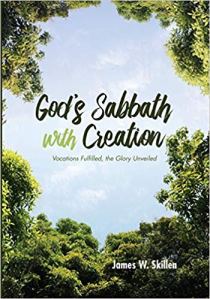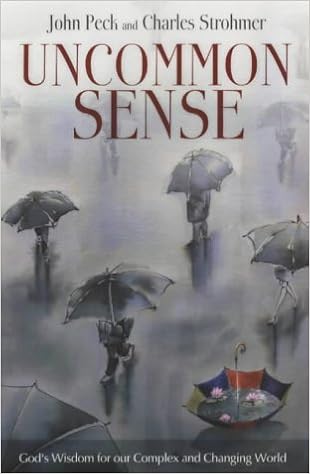God’s Sabbath with Creation: Vocations Fulfilled, the Glory Revealed
James W. Skillen
Wipf & Stock Publishers
368pp
Reviewed by Charles Strohmer
During the 1970s, the combined influence of books by Francis Schaeffer, the presidency of Jimmy Carter (the first self-described “born again” Christian), and the rise of the moral majority motivated many Christians to start reevaluating what it means to live in the world. A longstanding pietism in which Christians had opted out from as much of “the world” as they could possibly afford to gave way to a focus on social and political activism. This rather ad hoc and inchoate period of Christian rethinking and engagement had, by the 1990s, grown more visionary. An entire industry had arisen in Protestant circles for educating believers about serving God in all of life – work, art, philosophy, education, economics, science, the environment, and all the rest of it. The troubling tension of how to be in the world but not of the world had become passe. Now it was simply a matter of discovering how best to engage.
Today it is easy to find biblically-grounded books, conferences, activist non-profits, and courses in Christian colleges and universities nourishing and training believers in well-thought-out ways to live in the world for the glory of God in their chosen fields. As one of many writing and teaching voices of this expanding universe, I’ve had to keep abreast of developments. Space and time constraints preclude saying more about that universe here. Instead, I want to focus on James Skillen’s remarkable book God’s Sabbath with Creation: Vocations Fulfilled, the Glory Revealed.
This is a book of exceptional importance. Rarely have I come across a work with weightier significance about what it means to live for the glory of God today, in the here and now. Of course this is a theme familiar to Christians. Yet familiarity can breed inattention. That would be a mistake with God’s Sabbath with Creation. For it is Skillen’s pioneering way of getting us to think about what it means to live today for the glory of God that marks this as a standout book. His subject is the great biblical drama from the creation to the future we anticipate in the age to come, and, importantly, human responsibility within that drama. For Skillen places how we live today not in some existential moment but within God-commissioned human responsibilities, which run throughout history from the creation to the age to come. Even seasoned public voices on this subject should find the book stimulating and memorable.
Begun in seminary and college and continuing irregularly afterward, this book was a long time coming; it is easy to see why it is Skillen’s magnum opus. In it, he steps back from the subjects of his many previous books, which enter into problems of contemporary politics and obstacles to just governance (domestically and internationally). In God’s Sabbath with Creation he offers invigorating insights from decades of hard-won wisdom as an elder statesman in the body of Christ and a respected public figure who has wrestled with the Scriptures about the meaning of both the creation and human life as they are related to the future that Christians anticipate in the glory of the age to come. He aims to show, and in ways that may surprise, essential connections between the creation, how life in this world is lived, and the future that God has promised.
To set the stage, he writes that two questions had been growing on him throughout seminary and college: “1) is the fundamental identity of humans their sinfulness?, and 2) is the fundamental identity of Jesus that he is the savior of sinners?” He eventually concluded that “the sin-and-salvation story is an insufficient abstraction from the larger biblical story.” Although sin and salvation are fundamental to his thought, the book’s thesis takes seriously the larger biblical view that Jesus is not first of all the savior of sinners, and that humans are not first of all sinners. Instead, he explains, Jesus, the incarnate savior, is first of all the one through whom all things are created and hang together, and humans, though sinful, are first of all the creature made in the image of God. Having set that stage, Skillen raises the curtain on “how the sin-and-salvation story unfolds within God’s seven-day creation order, culminating in the celebration of divine glory in God’s sabbath with creation” (his emphasis).
 Because what we believe about the age to come is influenced by how we understand our origin, Skillen starts us on our journey to the anticipated future with a distinct interpretation of the seven days of creation. Calling attention to the Creator, he explains how and why Genesis chapters one and two tell the story “of God’s days, not sun-and-moon days, geological eons, or evolutionary stages.” In other words, “it is clear that the ‘time’ of God’s creation week does not belong to the time of our days and weeks under the solar-lunar order, which God establishes as his fourth creation day. God’s days constitute everything including the sun and moon days of God’s fourth day.”
Because what we believe about the age to come is influenced by how we understand our origin, Skillen starts us on our journey to the anticipated future with a distinct interpretation of the seven days of creation. Calling attention to the Creator, he explains how and why Genesis chapters one and two tell the story “of God’s days, not sun-and-moon days, geological eons, or evolutionary stages.” In other words, “it is clear that the ‘time’ of God’s creation week does not belong to the time of our days and weeks under the solar-lunar order, which God establishes as his fourth creation day. God’s days constitute everything including the sun and moon days of God’s fourth day.”
Especially important, he continues, “is the way the days are defined by their content, that is, by what God makes. . . . The text does not say, ‘On the third day, God made this or that,’ as if a sequence of days already existed and the creator simply made different things on each successive day. No, the creation days are God’s days and they are distinguished by what God makes.” Skillen helpfully illustrates this by noting that it is one of the ways we talk about time when speak of dinnertime, bedtime, or harvest time. “Each of those ‘times’ is defined by an action or subject matter, not by a pre-determined number of minutes, hours, or days. God’s seventh day does not even have an evening and morning, yet, it, too, is called a day – the day when God’s creation reaches its climax.”
A full range of thoughts about God’s days and God’s time, and connected topics, are developed in Part 1, themed as “Created Reality.” Topics include the evening and morning phrases of Genesis one, human identity, creation as architectural wonder, cosmic temple imagery, and the male and female image of God. Skillen has much to say about God’s days as encompassing all of creation, from beginning to fulfillment, and that the full reality of God’s seven-day creation week entails both this age and the age to come.
The stage is now set for us to move from being mere onlookers at the biblical drama to commissioned participators in it. Skillen writes that human identity includes “the exercise of high-level responsibilities in God’s creation,” and the theme of “human responsibility” is a central focus of the book. Skillen often discusses our many and varied responsibilities in this age in terms of our “sixth-day commission from God” – a commission that very much matters for the age to come. “The meaning and purpose of human life on earth has not yet reached fulfillment” because “men and women have not yet completed their sixth-day commission from God.”
Understanding human purpose on earth is essential to Christian thought. One of the invigorating insights Skillen makes to this is his way of including the nonhuman things of creation, which also very much matter for the age to come. For instance, “humans are unable to exercise their responsibilities without light from the sun, moon and stars, food to eat, water to drink, dry land to live on, plants and animals, and fellowship with one another and with God. . . .” Thus nonhuman creatures are made for distinctive purposes and functions. “Sun, moon, and stars govern the day and the night. Plants, trees, fish, fowl, and animals bear fruit or generate offspring.” Beyond that common understanding, every nonhuman creature, he writes, has its commission and reveals “something of God because they are constituted in their very identity to be revelatory in anticipation of the fulfilled creation.” The nonhuman creatures, then, “host humans as part of the creation’s hospitable welcome and praise of God. . . . That is why the psalmist [Psalm 148] can call on all of them to worship and praise God.”
Skillen’s emphasis on the nonhuman things of God’s creation is a key to his thesis of human responsibility throughout history. We live in “the arena of human generational development, a narrative that can be nothing other than the drama of sixth-day human creatures in their relations to one another, to all other creatures, and, above all, to God who orients the whole creation toward its seventh-day climax.” It is in this created context (nowhere else) that we have been given commissions to fulfill. “Humans are able to obey or disobey the creator, but they cannot sidestep or escape the responsibility inherent in their identity and commission from God.”
Throughout the book Skillen sheds fresh light on diverse responsibilities that we have – to God, to nonhuman creatures, to each other, and to all of life in the here and now – as we move through this world toward the future glory. These are responsibilities that include much more than practicing spiritual disciplines, such as faithful praying, or obvious moral behaviors, such as not flirting with the secretary and no longer cheating on your taxes. Human responsibilities are, he writes, “seemingly innumerable.” They are many and varied, multifaceted, vast in scope, and develop in ever-greater complexity over generations.
The book explores areas of responsibility that reach into the future, but that we may not have thought about, or that we may have decided to ignore as unimportant in the long run. Here is a sampling. Tilling and harvesting, animal husbandry, medical care, music-making, engineering, writing and speaking, exploring the microcosmic and the macrocosmic, economic development, public governance, clothing design, preparing food, working in the law courts, care for the elderly.
 Since “none of God’s six creation days has yet been wrapped up,” Skillen argues that every human responsibility is always contextualized within the ongoing days of creation, from the beginning. “With the unfolding of the human generations and the historical development of their talents and capabilities, their responses to God’s commission diversifies into a vast array of responsibilities. Humans name the animals, begin to tend the garden, bear children, and in the course of their generational unfolding discover more and more ways to develop the creation and their own talents in exercising royal and priestly responsibilities. Humans make music, invent tools, nurture friendships, engage in commerce, and govern clans, cities, and nations.”
Since “none of God’s six creation days has yet been wrapped up,” Skillen argues that every human responsibility is always contextualized within the ongoing days of creation, from the beginning. “With the unfolding of the human generations and the historical development of their talents and capabilities, their responses to God’s commission diversifies into a vast array of responsibilities. Humans name the animals, begin to tend the garden, bear children, and in the course of their generational unfolding discover more and more ways to develop the creation and their own talents in exercising royal and priestly responsibilities. Humans make music, invent tools, nurture friendships, engage in commerce, and govern clans, cities, and nations.”
Skillen connects his appeal for increased human responsibility to the word “vocation,” which appears first in the book’s subtitle and provides another key to his thought. He is not limiting the idea of vocation to the sense of a religious calling, such as to the ministry, nor to one’s chief occupation, or career. He does not preclude those senses of the word, but he is employing “vocation” somewhat correspondingly to what some call the “cultural mandate.” In fact, however, he is opening that mandate up in a way that may be surprising, yet hopefully helpfully so, to many Christians.
Here I am thinking of the Christian circles where an understanding of the cultural mandate has been framed by what has been called the seven mind molders, or seven spheres, of Christian influence: family, church (religion), education, media (distribution of information), government (law), business, and arts (including entertainment). Although Skillen does not directly engage with this framework of understanding, he certainly includes the seven areas as in need of being transformed by biblical thinking. But he unfolds and diversifies human responsibility into aspects of life, and, significantly, a way of thinking about them, well beyond even the most sophisticated developments of the seven mind molders paradigm.
There is much solid food in this large book, which is helpfully organized in seven parts, each with several short chapters that shed light on the continuity between the creation, what we do each day, and the future glory. Part 2 considers the meaning of four of creation’s “revelatory patterns,” which Skillen names with the doublets: honor and hospitality, commission towards commendation, covenant for community, and revelation in anticipation, including insights about the revelatory nature of creation. For instance, he writes: “The Garden of Eden, the tabernacle, the temple, the people of Israel, the body of Christ – all these reveal something about, and point toward, the climatic, seventh-day fulfillment of them all. Every earthly expression of God dwelling with his people and the people with God serve as revelatory images of God’s larger, creation-wide building project. The architectural wonder of creation is that all creatures in their glory are made for God, for relationship with God, and fulfillment in God’s unending sabbath celebration.”
Part 3 provides biblical examples of the “covenantal disclosure of reality,” which, Skillen explains, is cumulative and multi-generational in purpose from the beginning, forward moving in time from simplicity to complexity. This “dynamic of an ever-expanding revelation of God with, to, and through the human generations keeps intensifying in anticipation of the culminating fulfillment of all that has been, and is being revealed. To underestimate or to miss the intensification of this mounting covenantal disclosure is to miss the revelatory and anticipatory character of God’s purposes for and with creation.”
Parts 4, 5, and 6 take up themes of lively debate in biblical interpretation today, to show how an understanding of creation as God’s seven-day week sheds light on those subjects. These three parts explore the relation of the first Adam to the last Adam, the biblical tension between the “already” and the “not yet” of God’s kingdom, and, relying on Romans 9-11 and Hebrew 4, the historically weighty questions of the relation of God’s covenant with Israel to the new covenant in Messiah Jesus, to the church, and to what Skillen calls “becoming Bethel.”
The book abounds with a mature, biblically-based practical wisdom for running the race that has been set before us in the here and now, as individuals, groups, institutions, and nations in anticipation of entering into God’s rest, the seventh day of creation. Part 7, in fact, includes much discussion about wisdom itself. There, Skillen has averred that wisdom is what parents need for nurturing loving families through many stages of development and unanticipated crises. It is what government officials need for conducting sound statecraft and to uphold justice. It is what responsible farmers, engineers, teachers, artists, entrepreneurs, and others of all sorts need “for the development and practice of their distinctive crafts, the organizing of interrelated disciplines, and for training apprentices who will eventually be able to go beyond their mentors in creative and fruitful achievements.”
When “humans conduct their affairs worthily, build sound institutions as well as trustworthy relationships, and do right by one another and other creatures, then they reveal something of the wisdom and glory of God that anticipates the full disclosure of the glory in the age to come.” In short: “Wisdom is not first of all a tool for survival, but the fuel for flourishing in God’s creation as we learn to know ourselves ever more truly in the process of knowing God ever more profoundly.”
The book’s aim, then, is broadly threefold, weaving together the creational, the teleological, and the eschatological. In these three areas, pastors, seminary and university professors,  and students who work in the area of biblical studies will benefit from Skillen’s clarifying insights throughout the book as he engages with the views of prominent theologians, philosophers, and scholars. Among them: N. T. Wright, Jürgen Moltmann, Abraham Kuyper, Karl Barth, Craig Bartholomew, Meredith Kline, Herman Ridderbos, Eric Voegelin, Richard Gaffin, and Terence Fretheim. Skillen’s many generously footnoted, discerning outcomes with his interlocutors alone are worth having this book to-hand, as does its bibliography and extensive index.
and students who work in the area of biblical studies will benefit from Skillen’s clarifying insights throughout the book as he engages with the views of prominent theologians, philosophers, and scholars. Among them: N. T. Wright, Jürgen Moltmann, Abraham Kuyper, Karl Barth, Craig Bartholomew, Meredith Kline, Herman Ridderbos, Eric Voegelin, Richard Gaffin, and Terence Fretheim. Skillen’s many generously footnoted, discerning outcomes with his interlocutors alone are worth having this book to-hand, as does its bibliography and extensive index.
Having said that, I should add that just about anyone with a serious interest in the Bible will benefit from the book, even those who run across an occasional page where they may be unfamiliar with an idea of one of Skillen’s interlocutors. The footnotes for any such moment may prove helpful, but if not, I would suggest just keep reading. You don’t need to grasp all of the more specialized ideas to benefit from the book’s overall wisdom. On the other hand, readers who hold to an eighth-day view of the age to come, or those with a prodigal exuberance for being transported to the streets of gold, may be particularly challenged.
All readers, however, even if meeting with new ideas at times, will journey through God’s Sabbath with Creation in the kind of rest that is classic Skillen, writing, as he does, with a humility and grace that gives readers room to make their own decisions. Even when he is critically engaging with his scholarly interlocutors, collegiality stands out. The spirit and tone of the book is a refreshing relief from the incessant viewpoint screaming on social media and the braying of absolutized social and political values and interests by so many pundits.
Skillen summons us to reach toward maturity in our many and varied responsibilities, to live a life worthy of the vocations we have received. Laurels are not to be rested on. Skillen has, through much experience, earned the wisdom to admonish us where that is needed. He points out, clearly and perceptively, paths whose means and ends, if we follow any, will prevent us from being all that we can be as the image of God in our world. We may, to note just one here, fall prey to a subtle reliance on the ideals of freedom and human autonomy. In short, “self-generated preferences” must go. Instead, what is required is our “attentive listening above all to God and to the reality of God’s ordered creation, a reality which we did not create and in which we are not the only creature.” We have “God’s promises of a reordered world,” he writes, ever mindful that “there are no cheap and quick answers for those suffering great harms.”
In rabbinic thought, there is an old parable that seeks to aid in understanding God’s call of Abram to leave home (Genesis 12:1). The gist of the parable is this. Abram has left Tehran, his home, and while traveling he is bewildered by all the injustices and evil he sees during his travels from place to place. Somewhere he becomes deeply distressed when seeing a palace in flames. If its owner went to all the trouble to build something so beautiful, he wonders, why isn’t he looking after it, why does he leave it to the flames? While pondering this evil, the owner of the palace looks out at him and says, “I am the owner of the palace.” Suddenly the penny drops for Abram and he associates the experience with God and God’s good creation. He now understands that God has not abandoned his creation, not left it to the flames.
Modern rabbis tend to interpret the parable as a calling for Abraham to instruct his children and posterity to fight against the moral disorder, bloodshed, and chaos of the world by keeping the way of the Lord by doing what is just and right (Genesis 18:19). In the words of Rabbi Shai Held, Abraham “and his descendants are called to embody a different way of being in the world, to present a living alternative to the horrors of the world as it is.”
James Skillen has given us a book about the meaning that Christian difference and presence can make in the world, today, in light of glory of the age to come. Like Abraham and the biblical prophets, we as Jesus Christ’s followers are called to embody a living alternative to the evil, injustice, and horrors of our day. Things are not currently what they should be. The creation is not yet what it is ultimately intended to be.
But the palace is not going to be destroyed. God’s Sabbath with Creation explores why, and how, maturing fulfillment of God-commissioned responsibilities play prominent roles in the great drama of what the creation is ultimately intended to be, when, as Skillen concludes, the time of God’s sabbath arrives – the seventh day creation – when human will rest from their labors in God’s rest.
©2020 by Charles Strohmer
Images: courtesy of Creative Commons, in this order: Sam Mac Entee, National Geographic Society, Samantha Sophia
















